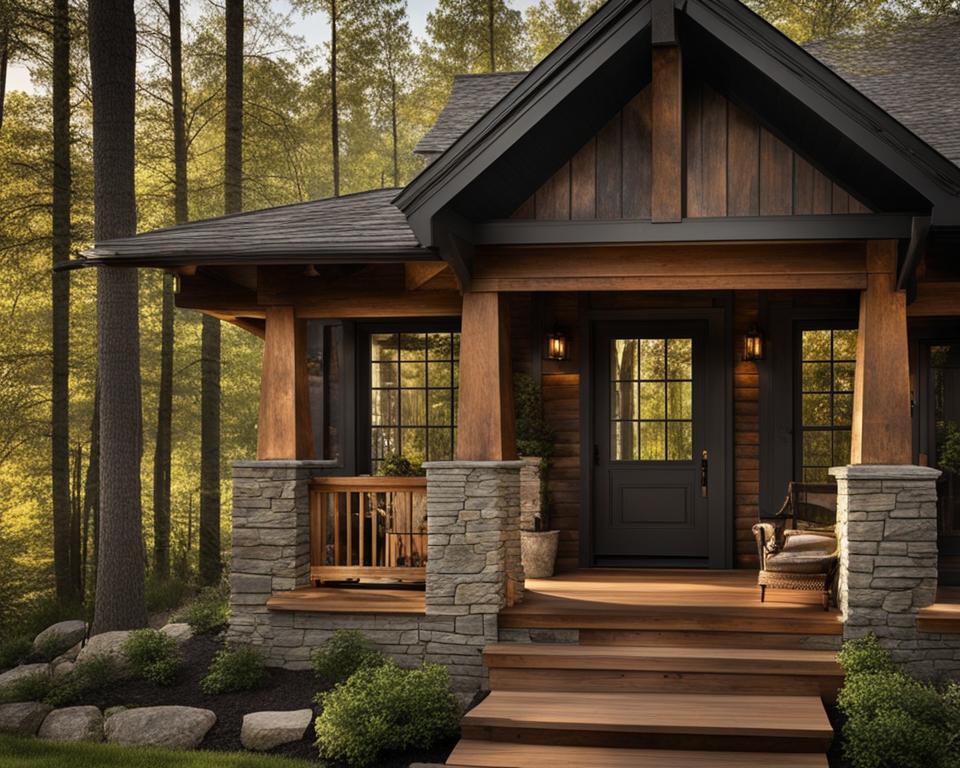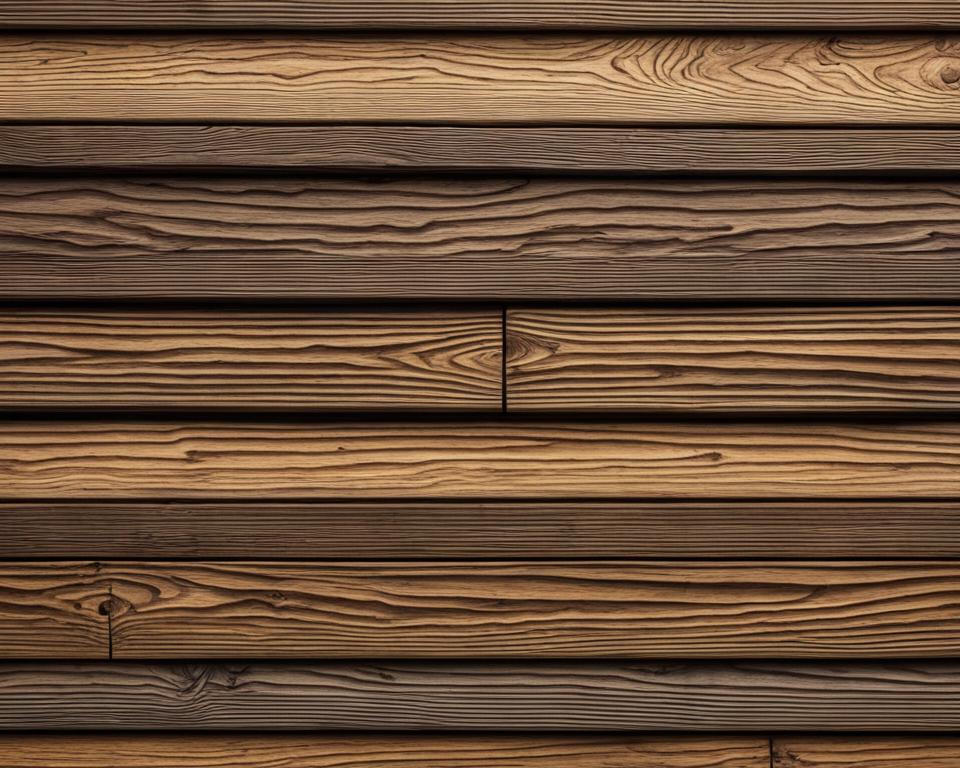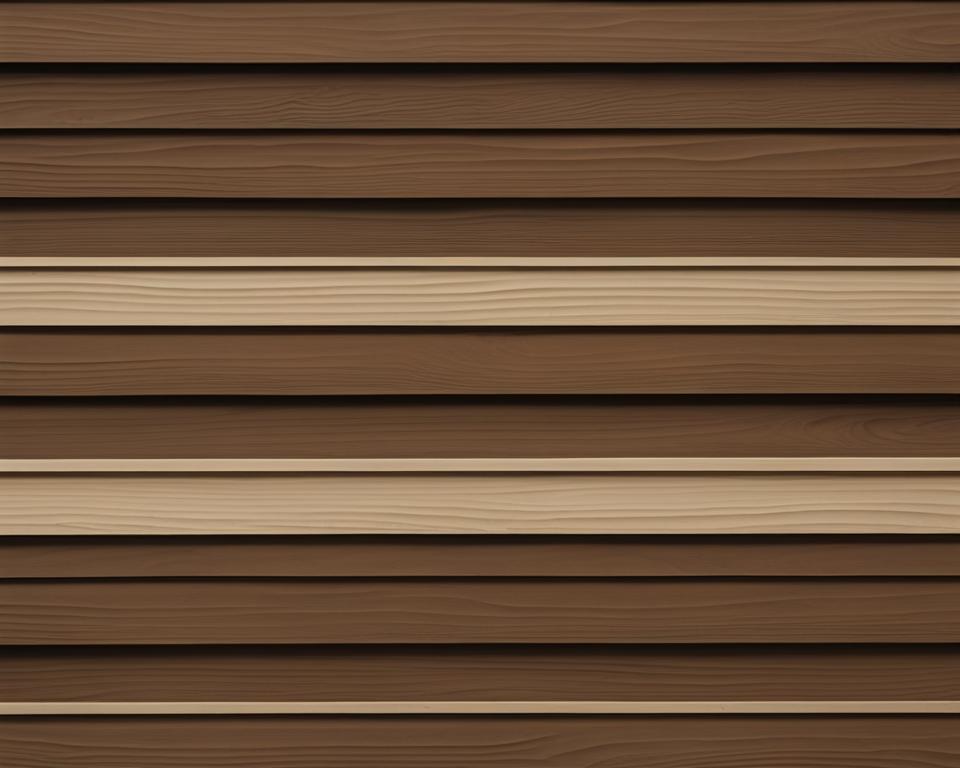Welcome to our guide on the differences between Dutch lap siding and traditional siding. When it comes to enhancing the exterior of your home, these two siding options are popular choices for homeowners. Each style has its own unique features and characteristics that set them apart. Let’s explore the differences and benefits of each type of siding to help you determine which one is best for your home.
Key Takeaways:
- Dutch lap siding and traditional siding are two popular options for enhancing the exterior of your home.
- Traditional lap siding is versatile and works well with various architectural styles, while Dutch lap siding has a unique and distinctive appearance.
- Choosing the best siding material is essential, with fiber cement siding being a top choice for its durability and longevity.
- Consider the architectural style of your home and the desired aesthetic when deciding between dutch lap siding and traditional siding.
- When comparing durability and maintenance, fiber cement lap siding offers exceptional durability and minimal upkeep.
Understanding Traditional Lap Siding
Traditional lap siding, also known as clapboard siding, has stood the test of time as a versatile and timeless choice for homeowners. This horizontal siding style involves overlapping long boards or panels, creating a clean and traditional aesthetic that complements various architectural styles.
One of the key benefits of traditional lap siding is its versatility. It can be combined with other siding styles to highlight specific design features and create a unique home exterior. Whether you have a modern or a more traditional home, traditional lap siding can enhance its overall appearance and provide a classic look that never goes out of style.
With its clean lines and horizontal orientation, traditional lap siding offers a sense of visual stability and balance to the exterior of your home. It provides a sense of harmony that is pleasing to the eye and adds curb appeal. This siding style is also available in a wide range of materials, including wood, vinyl, and fiber cement, giving homeowners the flexibility to choose the option that suits their preferences and budget.
In addition to its timeless appeal and versatility, traditional lap siding offers several other benefits. It provides excellent protection against the elements, helping to shield your home from wind, rain, and temperature fluctuations. The overlapping installation method helps to create a weatherproof barrier, keeping moisture out and maintaining the integrity of your home’s structure.
Another advantage of traditional lap siding is its relatively easy installation and maintenance. The boards or panels are easy to handle and can be secured in place with nails or screws. Regular maintenance, such as cleaning and repainting, can help prolong the lifespan of the siding and keep it looking its best for years to come.

Overall, traditional lap siding offers a versatile and lasting siding style that can enhance the aesthetic appeal and protection of your home. Its timeless look, combined with its ability to complement various architectural styles, makes it a popular choice among homeowners. Whether you prefer the natural beauty of wood or the low maintenance of vinyl or fiber cement, traditional lap siding is a reliable and attractive option to consider when upgrading your home’s exterior.
Exploring Dutch Lap Siding
Dutch lap siding is a variant of traditional lap siding that offers a unique and distinctive appearance. Similar to traditional lap siding, it is installed horizontally with overlapping boards. However, Dutch lap siding features a notch at the bottom of each plank, creating a shadow effect on the row below. This design element adds visual interest and sets it apart from traditional siding options. Dutch lap siding is versatile and can be installed in a variety of colors to complement different house styles.

Dutch lap siding’s distinctive appearance enhances the aesthetic appeal of a home, making it stand out from the crowd. The unique shadow effect created by the notched reveal adds depth and character to the exterior. This siding style can lend a touch of elegance and charm to both classic and contemporary architectural designs.
Aside from its visual appeal, Dutch lap siding also offers practical benefits. The overlapping boards provide an extra layer of protection against the elements, helping to keep the interior of the home safe and dry. Additionally, the horizontal installation of Dutch lap siding allows for easy maintenance, as individual boards can be replaced or repaired if necessary.
Advantages of Dutch Lap Siding
- Unique and distinctive appearance
- Versatile and available in various colors
- Enhanced protection against the elements
- Easy maintenance and repair
“Dutch lap siding adds a touch of elegance and uniqueness to any home. Its distinctive design and versatility make it a popular choice among homeowners looking to make a statement with their exterior.”
In summary, Dutch lap siding offers a unique siding style that sets it apart from traditional options. Its distinctive appearance, created by the notched reveal, adds visual interest and depth to the exterior of a home. Along with its aesthetic appeal, Dutch lap siding provides practical benefits such as enhanced protection and easy maintenance. If you’re looking for a siding style that combines both charm and functionality, Dutch lap siding is an excellent choice.
Choosing the Best Siding Material
When it comes to selecting the best siding material for your home, durability and longevity are key factors to consider. Lap siding, available in various materials such as wood, vinyl, and fiber cement, offers different advantages and characteristics. However, fiber cement siding, like James Hardie, stands out as a top choice for its exceptional durability and other benefits.
Fiber cement siding is renowned for its ability to withstand the test of time. It is highly resistant to impact, pests, and moisture damage, making it an ideal choice for homeowners seeking a long-lasting siding option. With its advanced technology, fiber cement siding offers superior protection against rot, warping, and cracking, ensuring the longevity of your home’s exterior.
One of the standout features of fiber cement lap siding is its wide range of styles, colors, and textures. Whether you prefer a modern or traditional look, fiber cement siding can be customized to suit your aesthetic preferences. This versatility allows homeowners to achieve the desired curb appeal and complement their home’s architectural style.

Not only does fiber cement lap siding offer outstanding durability and customization options, but it also requires minimal maintenance. Unlike wood siding that may require regular painting and sealing or vinyl siding that can be prone to damage in extreme weather conditions, fiber cement siding is designed to be low maintenance. With its long-lasting color retention and resistance to fading, homeowners can enjoy a beautiful and vibrant exterior without the hassle of frequent upkeep.
Furthermore, choosing fiber cement lap siding comes with the added confidence of a 30-year product warranty and a 15-year finish warranty. This warranty coverage provides homeowners with peace of mind, knowing that their investment is protected.
In summary, fiber cement siding is the best siding material choice for its exceptional durability, customization options, low maintenance requirements, and warranty coverage. Its ability to withstand the elements while maintaining its aesthetic appeal makes it a reliable and long-lasting investment for homeowners.
Finding the Right Style for Your Home
When it comes to choosing the perfect siding for your home, considering the architectural style is key. Both dutch lap siding and traditional siding can complement different architectural styles, but each has its own unique characteristics that may better suit certain designs.
Traditional lap siding is a versatile option that works well with almost any architectural style. Its clean, horizontal lines create a timeless look that can enhance the appeal of both modern and traditional homes.
“Traditional lap siding’s versatility makes it a popular choice for homeowners who want a classic look that adapts to various architectural styles.”
On the other hand, dutch lap siding shines when paired with traditional house styles such as Colonials, Gambrels, Victorians, and Greek Revivals. The notched reveal at the bottom of each plank adds a distinctive touch, creating a shadow effect that adds visual interest to your home’s facade.
When selecting the siding color scheme, it’s important to consider how it will enhance the unique features of each style. With traditional lap siding, the color options are nearly limitless, allowing you to create a cohesive and harmonious look with your home’s overall design. For dutch lap siding, choosing colors that highlight the shadow effect and emphasize the notched reveal can create a stunning visual impact.
Which Style is Right for You?
When deciding between dutch lap siding and traditional siding, there are a few factors to consider:
- Architectural Style: Consider the architectural style of your home and choose the siding style that complements it best.
- Desired Aesthetic: Think about the look and feel you want to achieve. Traditional lap siding offers a timeless appeal, while dutch lap siding adds a touch of uniqueness.
- Siding Color Schemes: Choose colors that enhance the features of each style and suit your personal preferences.
By taking these factors into account, you can find the perfect siding style that not only enhances your home’s curb appeal but also reflects your personal taste and style.
Comparing Durability and Maintenance
The durability and maintenance requirements of lap siding can vary depending on the material chosen. Here’s a comparison of the three most common siding materials: wood, vinyl, and fiber cement.
Wood Lap Siding
Wood lap siding offers a classic and natural aesthetic, but it requires regular maintenance to protect against moisture, insects, and sun damage. Homeowners need to regularly paint or stain wood siding to maintain its durability and prevent rotting or warping. Without proper maintenance, wood lap siding can deteriorate quickly, leading to costly repairs.
Vinyl Lap Siding
Vinyl lap siding is a popular choice due to its affordability and low-maintenance characteristics. It is relatively resistant to moisture and pests, and it does not require painting or staining. However, vinyl can be prone to damage in extreme weather conditions such as strong winds or hail. Over time, the color of vinyl siding can also fade due to sun exposure, requiring replacement to maintain its appearance.
Fiber Cement Lap Siding
Fiber cement lap siding, such as James Hardie siding, offers exceptional durability and minimal maintenance requirements. It is a composite material made of cement, sand, and cellulose fibers, making it resistant to rot, mold, pests, and damage from the elements. Fiber cement lap siding provides long-lasting protection for your home’s exterior while maintaining its attractive appearance. Additionally, it is available in a wide range of colors and textures to suit any architectural style.
| Siding Material | Durability | Maintenance |
|---|---|---|
| Wood | Requires regular maintenance to prevent rotting and warping | Regular painting or staining |
| Vinyl | Resistant to moisture and pests, but can be damaged in extreme weather conditions | Minimal maintenance; color may fade over time |
| Fiber Cement | Exceptionally durable and resistant to rot, mold, pests, and damage from the elements | Minimal maintenance required |
Based on the comparison, fiber cement lap siding offers the highest level of durability with minimal maintenance requirements. It is a long-lasting and cost-effective choice for homeowners looking for a siding material that can withstand various weather conditions and protect their homes from potential damage.
Making the Best Choice for Your Home
When it comes to choosing the right siding for your home, there are several important considerations to keep in mind. From the architectural style of your home to your personal aesthetic preferences, each factor plays a crucial role in determining the best option for you. Additionally, exploring different materials and styles, such as metal lap siding, can provide added benefits and long-term durability.
Considerations for Siding:
- The architectural style of your home: Different siding styles may complement certain architectural designs better than others. It’s essential to choose a siding option that enhances the overall look and feel of your home.
- Your personal aesthetic preferences: Your siding choice should align with your personal style and visual preferences. Whether you prefer a traditional, rustic, or modern look, there are siding options available to suit your taste.
- Maintenance requirements: Some siding materials require more upkeep than others. Understanding the maintenance needs of each siding option will help you make an informed decision.
Metal lap siding, such as steel, offers exceptional durability and longevity. It is resistant to rot, pests, fire, and harsh weather conditions. With minimal maintenance requirements, metal lap siding can be a great choice for homeowners seeking a low-maintenance and long-lasting option. It provides excellent protection for your home while adding a sleek and modern aesthetic appeal.
To help you further in your decision-making process, let’s compare the durability and maintenance aspects of different siding materials:
Siding MaterialDurabilityMaintenanceWoodProne to rot, insect damage, and warpingRequires regular painting, staining, and sealingVinylDurable, but can be prone to damage in extreme weather conditionsLow maintenance, occasional cleaning requiredFiber CementHighly durable, resistant to rot, pests, and weather damageMinimal maintenance, requires periodic paintingMetal (Steel)Exceptional durability, resistant to rot, pests, fire, and harsh weather conditionsMinimal maintenance, resistant to fading and chipping
As you can see, metal lap siding offers superior durability and requires minimal maintenance, making it an excellent choice for homeowners seeking a balance between aesthetics and practicality.
Remember, the best choice for your home ultimately depends on your specific needs, preferences, and the unique characteristics of your property. Consulting with a siding expert can help you navigate the options and make the best decision for your home’s exterior.
Conclusion
When it comes to choosing between dutch lap siding and traditional siding, the decision ultimately boils down to personal preference and specific considerations for your home. Both options offer unique styles and benefits, making it important to evaluate factors such as durability, maintenance, and aesthetic appeal.
Dutch lap siding boasts a distinctive appearance with its notched reveal, creating a shadow effect that sets it apart from traditional siding options. It pairs well with traditional architectural styles and can be installed in various colors to complement your home. On the other hand, traditional lap siding is a versatile option that works well with almost any architectural style, providing a timeless and clean look.
To make the best choice for your home, it is recommended to consult with a trusted siding expert. They can guide you in understanding the differences between dutch lap siding and traditional siding, as well as help you assess your specific needs and preferences. With their expertise, you can find the perfect siding solution that offers durability, low maintenance, and enhances the aesthetic appeal of your home.
FAQ
What is the difference between dutch lap siding and traditional siding?
Dutch lap siding features a notch at the bottom of each plank, creating a shadow effect on the row below, while traditional siding does not have this design element.
What are the benefits of traditional lap siding?
Traditional lap siding is versatile and works well with various architectural styles. It can be combined with other styles to highlight specific design features and create a unique home exterior.
What makes dutch lap siding unique?
Dutch lap siding offers a distinctive appearance with its notched reveal, creating a shadow effect. It adds visual interest and sets it apart from other siding options.
What is the best siding material?
Fiber cement siding, like James Hardie, is a top choice for its exceptional durability, impact resistance, and resistance to pests and moisture damage.
Can lap siding be used with any architectural style?
Traditional lap siding works well with almost any architectural style, while Dutch lap siding pairs well with traditional styles such as Colonials, Gambrels, Victorians, and Greek Revivals.
What should I consider when choosing the color scheme for lap siding?
The color scheme of the siding should be chosen carefully to enhance the shadow effect of the notched reveal in Dutch lap siding.
What are the durability and maintenance requirements of lap siding?
Wood lap siding requires regular maintenance, vinyl lap siding is relatively low-maintenance but can be prone to damage in extreme weather conditions, and fiber cement lap siding offers exceptional durability and requires minimal maintenance.
How do I make the best choice for my home?
Consider the architectural style of your home, your personal aesthetic preferences, and the maintenance requirements of the siding material. Consulting with a trusted siding expert can help you make an informed decision.
